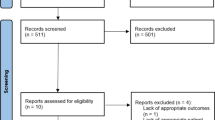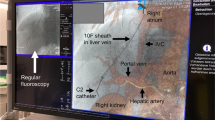Abstract
Steady progress is being made in endoscopic biliary intervention, especially endoscopic ultrasonography (EUS)-guided procedures. The EUS-guided rendezvous technique (EUS-RV) is a salvage method for failed selective biliary cannulation. The overall success rate of EUS-RV in 247 cases from seven published articles was 74 % and the incidence of complications was 11 %. The main cause of failed rendezvous cannulation was difficulty passing a biliary stricture or papilla due to poor guidewire (GW) manipulation. A recent large study found a 98.3 % success rate and superiority to precutting. This report suggested using a hydrophilic guidewire. Major complications were bleeding (0.8 %), bile leakage (1.2 %), peritonitis (0.4 %), pneumoperitoneum (0.2 %), and pancreatitis (1.6 %). The approach routes for EUS-RV were transgastric, transduodenal short position, and transduodenal long position. The appropriate route for each patient should be used. GW selection for EUS-RV is critical, and a hydrophilic GW might be the most useful. The catheter can be inserted through the papilla alongside or over the wire. Alongside cannulation is convenient, but difficult. The problem with the over-the-wire technique is withdrawal of the GW in the accessory channel. EUS-RV is effective and safe, but is not established. The efficacy should be confirmed in a prospective comparative trial, and the necessary specialist equipment should be developed.



Similar content being viewed by others
Abbreviations
- GW:
-
Guide-wire
- EUS:
-
Endoscopic ultrasonography
- EUS-RV:
-
Endoscopic ultrasonography-guided rendezvous technique
- PTBD:
-
Percutaneous transhepatic biliary drainage
- ERCP:
-
Endoscopic retrograde cholangiopancreatography
- TG:
-
Trans-gastric
- TD:
-
Trans-duodenal
- TDS:
-
Trans-duodenal short position
- TDL:
-
Trans-duodenal long position
- EUS-CDS:
-
Endoscopic ultrasonography-guided choledochoduodenostomy
- ALC:
-
Alongside cannulation
- OWC:
-
Over-the-wire cannulation
References
Freeman ML. ERCP cannulation: a review of reported techniques. Gastrointest Endosc. 2005;61:112–25.
Isayama H, Kawakubo K, Kato H, Itoi T, Kawakami H, Hanada K, et al. Japanese multicenter experience of EUS-guide biliary drainage (EUS-BD). UEGW2012 2012;OP089.
Isayama H, Nakai Y, Kawakubo K, Koike K. Recent progress in endoscopic ultrasonography guided biliary intervention. Clin J Gastroenterol. 2012;2:93–100.
Shah JN, Marson F, Weilert F, Bhat YM, Nguyen-Tang T, Shaw RE, et al. Single-operator, single-session EUS-guided anterograde cholangiopancreatography in failed ERCP or inaccessible papilla. Gastrointest Endosc. 2012;75:56–64.
Iwashita T, Lee JG, Shinoura S, Nakai Y, Park DH, Muthusamy VR, et al. Endoscopic ultrasound-guided rendezvous for biliary access after failed cannulation. Endoscopy. 2012;44:60–5.
Dhir V, Bhandari S, Bapat M, Maydeo A. Comparison of EUS-guided rendezvous and precut papillotomy techniques for biliary access (with videos). Gastrointest Endosc. 2012;75:354–9.
Kim YS, Gupta K, Mallery S, Li R, Kinney T, Freeman ML. Endoscopic ultrasound rendezvous for bile duct access using a transduodenal approach: cumulative experience at a single center. A case series. Endoscopy. 2010;42:496–502.
Maranki J, Hernandez AJ, Arslan B, Jaffan AA, Angle JF, Shami VM, et al. Interventional endoscopic ultrasound-guided cholangiography: long-term experience of an emerging alternative to percutaneous transhepatic cholangiography. Endoscopy. 2009;41:532–8.
Brauer BC, Chen YK, Fukami N, Shah RJ. Single-operator EUS-guided cholangiopancreatography for difficult pancreaticobiliary access (with video). Gastrointest Endosc. 2009;70:471–9.
Kahaleh M, Hernandez AJ, Tokar J, Adams RB, Shami VM, Yeaton P. Interventional EUS-guided cholangiography: evaluation of a technique in evolution. Gastrointest Endosc. 2006;64:52–9.
Kida M, Araki M, Miyazawa S, Ikeda H, Kikuchi H, Watanabe M, et al. Fine needle aspiration using forward-viewing endoscopic ultrasonography. Endoscopy. 2011;43:796–801.
Voermans RP, Ponchon T, Schumacher B, Fumex F, Bergman JJ, Larghi A, et al. Forward-viewing versus oblique-viewing echoendoscopes in transluminal drainage of pancreatic fluid collections: a multicenter, randomized, controlled trial. Gastrointest Endosc. 2011;74:1285–93.
Iwashita T, Nakai Y, Lee JG, Lee JG, Park do H, Muthusamy VR, Chang KJ. Newly-developed, forward-viewing echoendoscope: a comparative pilot study to the standard echoendoscope in the imaging of abdominal organs and feasibility of endoscopic ultrasound-guided interventions. J Gastroenterol Hepatol. 2012;27:362–7.
Dickey W. Parallel cannulation technique at ERCP rendezvous. Gastrointest Endosc. 2006;63:686–7.
Conflict of interest
H. Isayama declares no financial disclosure.
Author information
Authors and Affiliations
Corresponding author
About this article
Cite this article
Isayama, H., Nakai, Y., Kawakubo, K. et al. The endoscopic ultrasonography-guided rendezvous technique for biliary cannulation: a technical review. J Hepatobiliary Pancreat Sci 20, 413–420 (2013). https://doi.org/10.1007/s00534-012-0577-8
Published:
Issue Date:
DOI: https://doi.org/10.1007/s00534-012-0577-8




